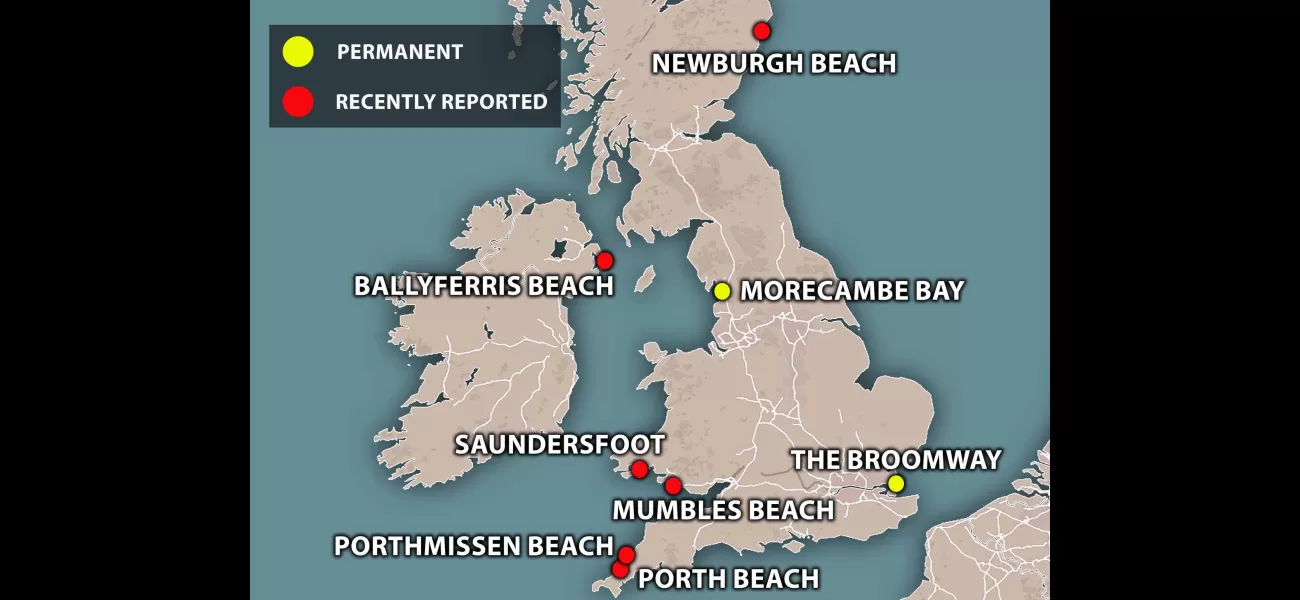A map shows where quicksand is most frequently found in the UK.
Stay alert.
June 12th 2024.

When the weather is finally nice, you may be tempted to head to the beach for a day of relaxation. However, after a woman's story of getting stuck in quicksand went viral, it's important to be aware of this hidden danger. Jamie Acord was out for a walk with her husband in Phippsburg, Maine when she suddenly found herself waist-deep in quicksand, unable to escape. Even though this happened across the Atlantic, quicksand has also caused trouble for people here in the UK. So, it's wise to know where to be cautious.
One of the most well-known spots for quicksand in the UK is Morecambe Bay in Cumbria. Just last month, a dog got stuck in quicksand for over an hour. Warning signs are posted for visitors, advising them of the danger not only from the quicksand, but also the quickly rising tides and hidden channels. In Essex, there is a path known as the Broomway, which has unfortunately claimed over one hundred lives throughout history. While some of these deaths were caused by the sinking sands, others were due to rushing tides and strong currents.
Contrary to what we may have seen in movies, people do not actually get completely submerged by quicksand and suffocate or drown. In fact, quicksand itself is not deadly. It is a mixture of sand and water that becomes saturated, creating a thick liquid-like consistency. This means that it cannot support the weight of a person standing on it. Similar to water, a person will naturally float on top of quicksand, so they will not continue sinking until they disappear, even if the patch they are in is deep.
If you do happen to find yourself stuck in quicksand, the first thing to do is stay calm. It's easy to become exhausted while trying to escape. The His Majesty's Coastguard (HMC) recommends that you sit back to evenly distribute your weight across the surface. If you are unable to "swim" out once you're on top of the quicksand, call 999 immediately and ask for the Coastguard. It's important to resist the urge to have others help you, as they may also become stuck.
It can be difficult to spot quicksand, as it can blend in with the surrounding sand. The HMC advises people to avoid crossing estuaries and walking through mud, as there may be hidden channels of fast-moving water. Sometimes, you may see water bubbling up through the sand or ripples on the surface, but often, it's not visible until you're already in it. The real danger of quicksand lies in the places where it usually forms, such as wide bays and estuaries with fast-moving tides. Once you're stuck, it's incredibly challenging to get out without assistance. Most deaths related to quicksand occur when the tide rises and causes drowning, not from the quicksand itself.
Fortunately, quicksand is not very common in the rest of the UK. However, it can form anywhere under the right conditions, particularly on beaches and tidal flats. In recent years, there have been reports of quicksand in Cornwall, Glamorgan, Pembrokeshire, and Aberdeenshire. So, it's essential to be cautious when near these areas and pay attention to any warning signs. With quicksand, prevention is key.
One of the most well-known spots for quicksand in the UK is Morecambe Bay in Cumbria. Just last month, a dog got stuck in quicksand for over an hour. Warning signs are posted for visitors, advising them of the danger not only from the quicksand, but also the quickly rising tides and hidden channels. In Essex, there is a path known as the Broomway, which has unfortunately claimed over one hundred lives throughout history. While some of these deaths were caused by the sinking sands, others were due to rushing tides and strong currents.
Contrary to what we may have seen in movies, people do not actually get completely submerged by quicksand and suffocate or drown. In fact, quicksand itself is not deadly. It is a mixture of sand and water that becomes saturated, creating a thick liquid-like consistency. This means that it cannot support the weight of a person standing on it. Similar to water, a person will naturally float on top of quicksand, so they will not continue sinking until they disappear, even if the patch they are in is deep.
If you do happen to find yourself stuck in quicksand, the first thing to do is stay calm. It's easy to become exhausted while trying to escape. The His Majesty's Coastguard (HMC) recommends that you sit back to evenly distribute your weight across the surface. If you are unable to "swim" out once you're on top of the quicksand, call 999 immediately and ask for the Coastguard. It's important to resist the urge to have others help you, as they may also become stuck.
It can be difficult to spot quicksand, as it can blend in with the surrounding sand. The HMC advises people to avoid crossing estuaries and walking through mud, as there may be hidden channels of fast-moving water. Sometimes, you may see water bubbling up through the sand or ripples on the surface, but often, it's not visible until you're already in it. The real danger of quicksand lies in the places where it usually forms, such as wide bays and estuaries with fast-moving tides. Once you're stuck, it's incredibly challenging to get out without assistance. Most deaths related to quicksand occur when the tide rises and causes drowning, not from the quicksand itself.
Fortunately, quicksand is not very common in the rest of the UK. However, it can form anywhere under the right conditions, particularly on beaches and tidal flats. In recent years, there have been reports of quicksand in Cornwall, Glamorgan, Pembrokeshire, and Aberdeenshire. So, it's essential to be cautious when near these areas and pay attention to any warning signs. With quicksand, prevention is key.
[This article has been trending online recently and has been generated with AI. Your feed is customized.]
[Generative AI is experimental.]
0
0
Submit Comment





